Uniwersytetu
1
Centrum Popularyzacji Nauki i Innowacji
Warmińsko-Mazurskiego ”Kortosfera”
trias book
TRIAS is at the forefront of the science center and museum industry in Poland. We create professional expositions – from concept to final venues.
01 | ABOUT



02 | HOW DO WE OPERATE?
THE CENTER FOR THE POPULARIZATION OF SCIENCE AND INNOVATION OF THE UNIVERSITY OF WARMIA AND MAZURY KORTOSFERA IN OLSZTYN
NATIONAL MARITIME MUSEUM IN GDANSK
SCIENCE ISLAND IN KAUNAS
CONTENTS
36
30 10



03 | COMPLETED PROJECTS
MARITIME SCIENCE CENTER IN SZCZECIN
50

GEN SCIENCE GENERATOR IN JASLO
EPI-CENTRE OF SCIENCE IN BIALYSTOK
64

EXPOSITION AT NATIONAL BANK OF POLAND
76


MUFO MUSEUM OF PHOTOGRAPHY IN CRACOW
84

EDUCATION CENTER OF THE WARTA MOUTH NATIONAL PARK IN SLONSK
102

NATIONAL MUSEUM OF TECHNOLOGY IN WARSAW
128 94

COPERNICUS SCIENCE CENTER IN WARSAW
138
MOTOEXPERYMENTARIUM - ART DEPOT IN SZCZECIN
110
ART DÉCO IN PLOCK
118
TRIAS GROUP
After more than 28 successful years it holds 6 subsidiaries, 2 non-profit organizations and employs 200 professionals –engineers, project managers, educational experts, designers, architects, software developers, etc.
TRIAS is the Polish prime contractor that creates science centers and museums - from design through implementation to ready to use facilities. Our company is a leader in providing tailor-made, 360-degree solutions for large scale projects.
TRIAS has carried out over 60 science center and museum projects during more than 28 years of activity. The company’s priority is to create unique exhibitions by integrating state-of-art multimedia systems and latest technology with traditional exhibits and vintage museum pieces. We also specialize in providing advanced audio, video, light solutions for domestic and international venues. Having an in-house Creative and Design Office and Software Development Office, we provide pitch perfect solutions, that are strongly based
Trias 01 6
About
STARTED IT’S ACTIVITY IN 1996
TRIAS GROUP
on customer needs. Both offices work closely together and deliver complete products: from a story, through concept, technical project, to executive project and implementation.
A group of professional, experienced project managers, technicians, as well as in-house Production Office, guarantee that final results are in line with the project and always meet our customers’ expectations. While designing, we always have the newest UX standards in mind. Our Creative Design team has a vast and impressive portfolio, including but not limited to science centers. Similarly Software Development team created many apps for various science centers and museums. Most of our engineers hold AVIXA CTS certificates that gu-
arantee highest level of technical knowledge and design practices. With cutting-edge multimedia solutions and hand-made products comes need of professional maintanance.
Digiservice, a subsidiary of TRIAS Group, is a company with more than 20 years of experience in the market, a reliable service partner for a wide range of science centers, museums, public institutions, sports facilities and business clients. It operates mainly in Poland but has numerous clients in European countries as well. More than 3000 satisfied customers has already benefited company’s expertise. Digiservice closely cooperates with TRIAS and services all our products.
7
02 | HOW DO WE OPERATE?

THE CENTER FOR THE POPULARIZATION OF SCIENCE AND INNOVATION OF THE UNIVERSITY OF WARMIA AND MAZURY
KORTOSFERA IN OLSZTYN
Olsztyn | Poland 02 Trias 10

11 01
TRIAS is responsible for design and creation of the exhibition of The Center for the Popularization of Science and Innovation of the University of Warmia and Mazury Kortosfera. The leading themes of the new exhibition space are agriculture, food, diet, health, nature and
the human impact on the environment. The exhibition is mainly based on interactive devices and combines multimedia and mechanical solutions. All this will surely make Kortosfera very popular with visitors of all age categories, especially younger viewers.
Trias 12 Olsztyn | Poland 02
1600 m 2 130 5 of floor space floors permanent exhibition pieces
PROJECT IN FIGURES:

YOUNG SPACE EXPLORERS

HOW TO FEED THE FUTURE?
HUMANA BEING THAT EATS
I SOW THEREFORE I AM
UNDERGROUND KINGDOM
13 The Center for the Popularization of Science and Innovation of the University of Warmia and Mazury Kortosfera in Olsztyn


Trias 14 Olsztyn | Poland 02
I
UNDERGROUND KINGDOM
SOW THEREFORE I AM
The Center for the Popularization of Science and
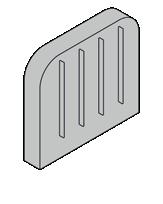
YOUNG SPACE EXPLORERS HOW TO FEED THE FUTURE? HUMAN - A BEING THAT EATS
15
the
Kortosfera in Olsztyn
Innovation of
University of Warmia and Mazury


Trias 16 Olsztyn | Poland 02 01 02 01 | Underground Kingdom thematic zone
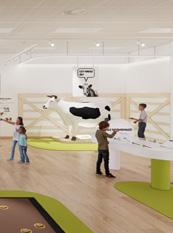
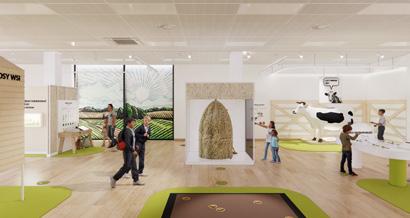

17 The Center for the Popularization of Science and Innovation of the University of Warmia and Mazury Kortosfera in Olsztyn 04 03 02 | 03 | 04 | I Sow therefore I am thematic zone

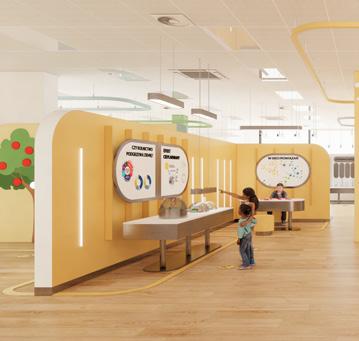
Trias 18 Olsztyn | Poland 02 05 05 | Human - a Being that Eats thematic zone
The construction of a major science center exhibition like Kortosfera is quite a challenge for the entire project team, which is why it was so important to have excellent cooperation between everyone involved. Scientists responsible for the substantive content, architects, graphic designers, technicians, programmers, carpenters, model makers - all worked tirelessly to create this unique place. Great attitude of the representatives of the contracting authority was another unquestionable advantage. A clear vision, ability to cooperate and understanding of common goals greatly facilitates the implementation of such a complex investment.
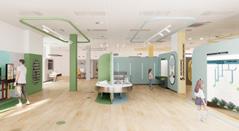

19 The Center for the Popularization of Science and Innovation of the University of Warmia and Mazury Kortosfera in Olsztyn
06 07 06 | 07 | How to feed the the future? thematic zone
- Roman Zwiejski, Project Manager at TRIAS responsible for the realization of Kortosfera
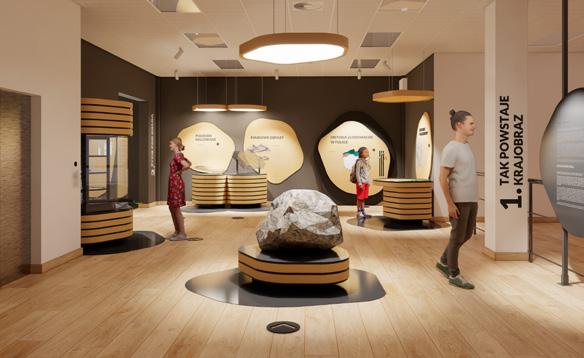
KORTOSFERA
Olsztyn | Poland 02 Trias 20
08
KORTOSFERA
The Center for the Popularization of Science and Innovation of the University of Warmia and Mazury Kortosfera
KORTOSFERA
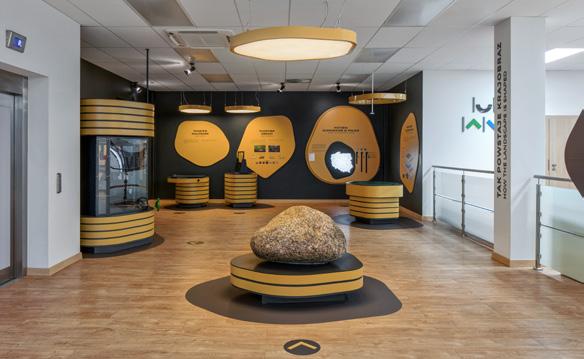
KORTOSFERA
21
08 | 09 | Underground Kingdom thematic zone 09
in Olsztyn



Trias 22 Olsztyn | Poland 02 10 | 11 | 12 | Sow therefore I am thematic zone 10 11 12
The
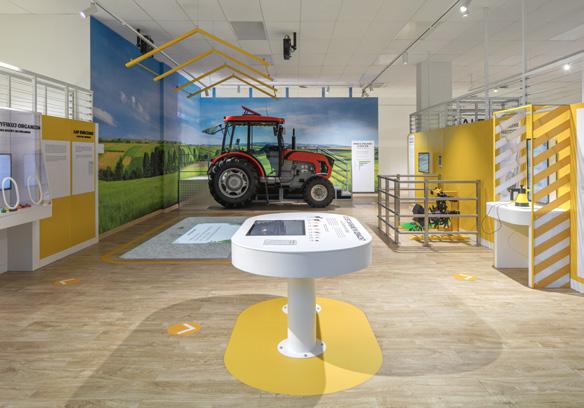


23
the
Kortosfera in Olsztyn 12 | 14 | Sow therefore I am thematic zone 13 14
Center for the Popularization of Science and Innovation of
University of Warmia and Mazury
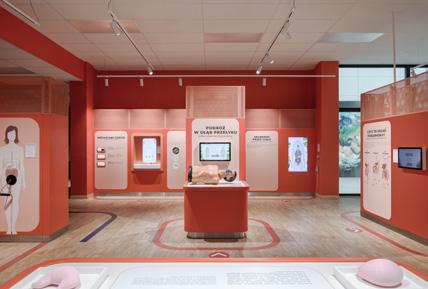
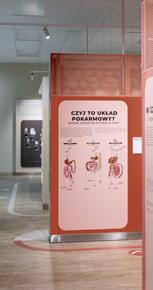

Trias 24 Olsztyn | Poland 02 15 | 16 | Human - a Being that Eats thematic zone
15 16


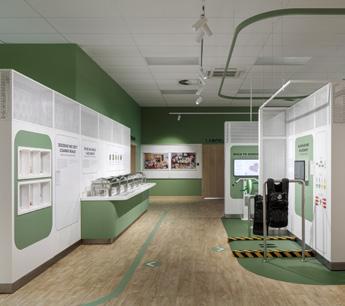
25
the Popularization of Science and Innovation of the University of Warmia and Mazury Kortosfera in Olsztyn 17 | 18 | 19 | Human - a Being that Eats thematic zone 19 17 18
The Center for


Trias Olsztyn | Polska 01 26 20 | 21 | How to feed the the future? thematic zone 20 21



27
of Science and Innovation of the University of Warmia and Mazury Kortosfera in Olsztyn 22 | 23 | How to feed the the future? thematic zone 23 22
The Center for the Popularization


Trias 28 Olsztyn | Poland 02 20 | 21 | 22 | How to feed the the future? thematic zone
The Center for the Popularization of Science and
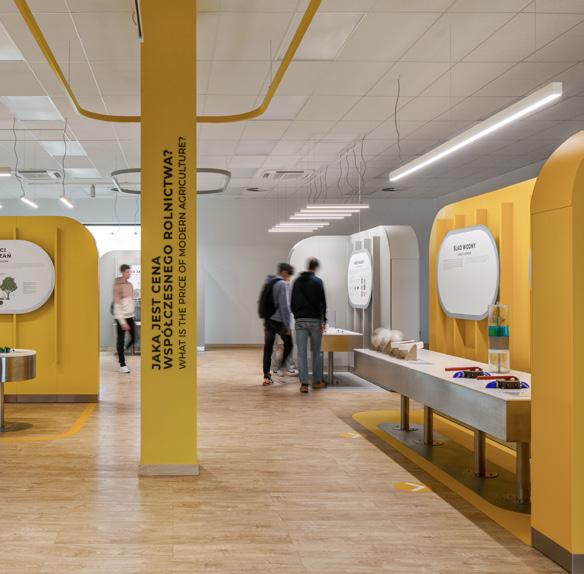
29
the
in Olsztyn 23 | 24 | 25 |How to feed the the future? thematic zone
Innovation of
University of Warmia and Mazury Kortosfera

EXHIBITION 100 YEARS OF THE POLISH SAILING IN NATIONAL MARITIME MUSEUM IN GDANSK
Trias Gdansk | Poland 02 30
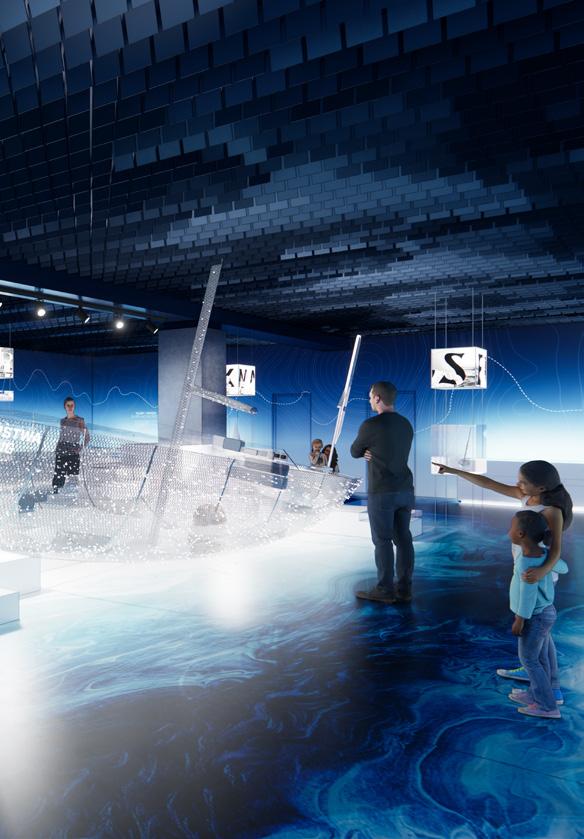
31 01
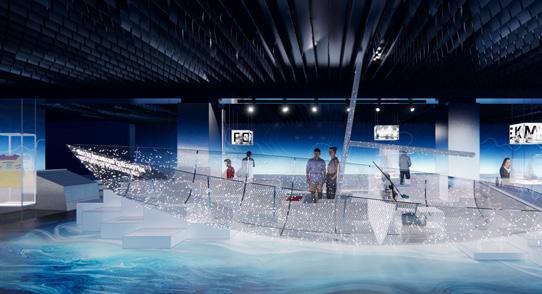
210 m 2 230 2622 of floor space permanent exhibits number of cloth fragments forming wind installations on the ceiling
The TRIAS Design Team was responsible for the design and author’s supervision of a new temporary exhibition at the National Maritime Museum in Gdansk, which was created in celebration of the 100th anniversary of the establishment of the Polish Yachting Association in 2024. The exhibition tells the story of Polish sea and
inland sailing. Visitors have the opportunity to learn about the people who created sailing achievements over the past century, see yachting accessories and equipment, clothing and everyday objects. There are also hand-on exhibits showcasing practical sailing knowledge.
Trias 32 02 Gdansk | Poland


The exhibition design, the graphics, the typography used or the elements of small architecture all relate directly to the main theme. The colors and shapes used in the creation of the scenography bring to mind the rough sea, which helps to create a coherent and immersive space. Navy blue and white reminiscent of fo-
amy waters and the depths of the sea dominate the floor, while the graphics on the walls are associated with a blurred horizon and refer to the infinity of the ocean. Set in the center, a dynamic, partially transparent structure in the shape of a yacht’s hull symbolizes the sailing adventure. It is the heart of the exhibition, com-
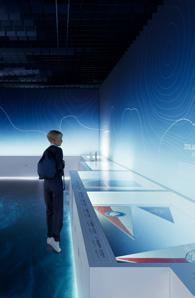
bining the history of Polish voyages with the spirit of sailing competition. While the installation on the ceiling, consisting of fragments of material moved by a gentle stream of air, refers to wind and waves.
33 Exhibition 100 years of the Polish Sailing in National Maritime Museum in Gdansk 02 | Voyages of Utmost Importance in History of Polish Sailing thematic zone 03 | displays showcasing sailing clothing 04 | Polish Community Sailing thematic zone
04 03 02
When embarking on the design of the exhibition 100 Years of Polish Sailing, we wanted visitors to feel the unique atmosphere of sea voyages and boundless depths. Helping to achieve this goal were a specially selected color scheme, the use of the element of wind and authentic attributes associated with sailing.

Trias 34 02 Gdansk | Poland
05| main visual identification element 05
- Klaudia Walaszek-Wieczorek, Architect at TRIAS

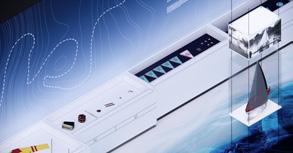
35 Exhibition 100 years of the Polish Sailing in National Maritime Museum in Gdansk 06 | Voyages of Utmost Importance in History of Polish Sailing thematic zone 07| Clubs and Districts thematic zone 07 06
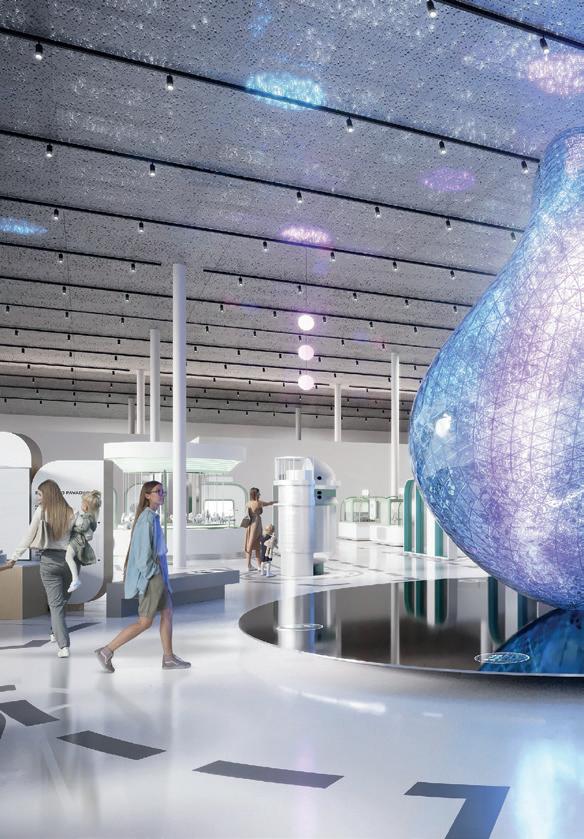
SCIENCE ISLAND
IN KAUNAS
Trias Kaunas | Lithuania 02 36

37 01
Science and Innovation Promotion Centre ‘Science Island’ will accommodate permanent and temporary expositions, a unique virtual projection space, STEAM laboratories, cafés and administrative part. 140 exhibits will create the permanent exhibition, while temporary exhibitions will be replaced once a year.
Trias 38 02 Kaunas | Lithuania
Main exposition consists of 7 themes: human body and health, food, nature and environment, waste and pollution, energy, transport and communication. Each space will stand out in its individual form and with its own exhibits. Eight part of the Science Center will be dedicated to the youngest visitors (3-6 years), adapted to their
cognitive needs. Here children will get acquainted with science through games, sensations, colors and shapes.
Elements of the new exhibition’s scenography will refer to modernism, which occupies an important place among Kaunas’ main architectural motifs. The sce-
nography was inspired by the city’s most recognizable Modernistic buildings: the Central Post Office, Žaliakalnis Funicular Raylway, M. K. Čiurlionis National Museum of Art, Vytautas the Great War Museum, Bank of Lithuania and others. The colors of the exhibition will be consistent with the architecture of the interior.
39 Science Island in Kaunas

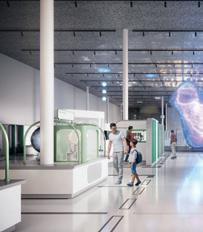

Trias 40 02 Kaunas | Lithuania 02 02 | Safe-Safer-the Safest? exhibit



We are delighted to be part of the Science Island project, especially since it is the first science center in Lithuania. As we are responsible for both design and creation, we can already say that it will be an exclusive object on the European scale. We have been on the Polish market for more than 28 years, and over the last few years we have focused on science centers, museums and exhibition spaces.
- Dawid Polasik, Commercial Director at TRIAS

41 Science Island in Kaunas
03 04 05 03 | I-Center exhibit 04 | Nature and Environment, Energy and Transport thematic zones 05 | Human Body and Health thematic zone
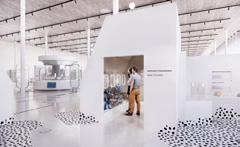

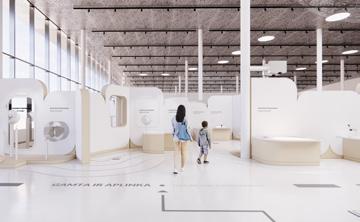
Trias 02 Kaunas | Lithuania Visualisation of the exhibit 4.01 How much trash do you produce 1.6.1.2.5. Visualisation of the central exhibit 3
07 06 06 | How Much Trash do You Produce? exhibit 07 | Nature and Environment thematic zone 42
View of the I-Center from

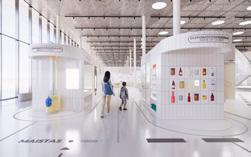

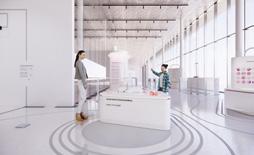
43 Science Island in Kaunas Visualisation of the exhibit 11 1.6.1.2.3. Visualisation of the exhibit 1 1.09 Body-building exhibit (I-Center) nr 1 3 the Energy theme 11 10 08 09 08 | Food thematic zone 09 | Glaciers Sculpting the Landscape exhibit 10 | I-Center exhibit 11 | Body-building exhibit
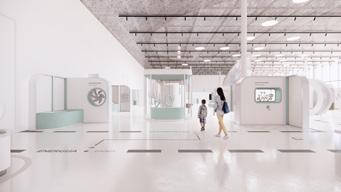


Trias 44 02 Kaunas | Lithuania 13 14 12 12 | 13 | Transport thematic zone 14 | Children’s Space


45 Science Island in Kaunas 16 15 15 | Energy Reviewed exhibit 16 | The Morse Code exhibit
1.6.1.2.5.
1.6.1.2.5.
1.6.1.2.5.
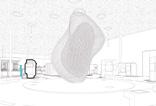

1.6.1.2.5.

1.6.1.2.5.
1.6.1.2.5.


1.6.1.2.5.




1.6.1.2.5.
1.6.1.2.5.
1.6.1.2.5.
Additional scheme of the central exhibit (I-Center)



Additional scheme of the central exhibit (I-Center)
Additional scheme of the central exhibit (I-Center)
The positive decision is immediately transmitted via light path to the lamp located above an exhibit.
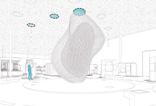


Additional scheme of the central exhibit (I-Center)
The positive decision is immediately transmitted via light path to the lamp located above an exhibit.
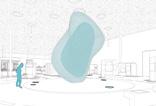





1.6.1.2.5.
After that the light falls directly into the middle of the sculture and creates a gentle, pulsing light effect.
After that the light falls directly into the middle of the sculture and creates a gentle, pulsing light effect.
Than it uses the light path on the ceiling to reach the central exhibit.
Than it uses the light path on the ceiling to reach the central exhibit.
it uses the light path on the ceiling to reach the central exhibit.






Additional scheme of the central exhibit (I-Center)
1.6.1.2.5. Additional scheme of the central exhibit (I-Center)
A positive decision is being made.
A positive decision is being made.
A positive decision is being made.
Then data and statistics, in form of floating dots, appear on three large screens hidden under a mirrored base.
Then data and statistics, in form of floating dots, appear on three large screens hidden under a mirrored base.
Additional scheme of the central exhibit (I-Center)
Then data and statistics, in form of floating dots, appear on three large screens hidden under a mirrored base.
After that the light falls directly into the middle of the sculture and creates a gentle, pulsing light effect. The positive decision is immediately transmitted via light path to the lamp located above an exhibit.
Additional scheme of the central exhibit (I-Center)
Additional scheme of the central exhibit (I-Center)
The positive decision is immediately transmitted via light path to the lamp located above an exhibit.
The positive decision is immediately transmitted via light path to the lamp located above an exhibit.
The positive decision is immediately transmitted via light path to the lamp located above an exhibit.
All the
All the data is summarized, collected from time to time, and sent to screens located in three benches.
All the data is summarized, collected from time to time, and sent to screens located in three benches.
Than it uses the light path on the ceiling to reach the central exhibit.
Than it uses the light path on the ceiling to reach the central exhibit.
Than it uses the light path on the ceiling to reach the central exhibit.





















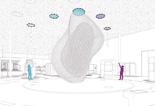





After that the light falls directly into the middle of the sculture and creates a gentle, pulsing light effect.
Visitors make opposing decisions.
Visitors make opposing decisions.
Visitors make opposing decisions.
After that the light falls directly into the middle of the sculture and creates a gentle, pulsing light effect.
Visitors make opposing decisions.
Visitors make opposing decisions.
After that the light falls directly into the middle of the sculture and creates a gentle, pulsing light effect.
Visitors make opposing decisions.

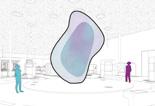




Next lights fall directly into the middle of the sculture and mix together, while pulsing at the same time.
Next lights fall directly into the middle of the sculture and mix together, while pulsing at the same time.
Next lights fall directly into the middle of the sculture and mix together, while pulsing at the same time.
Next lights fall directly into the middle of the sculture and mix together, while pulsing at the same time.
Next lights fall directly into the middle of the sculture
Next lights fall directly into the middle of the sculture and mix together, while pulsing at the same time.
Then data and statistics, in form of floating dots, appear on three large screens hidden under a mirrored base.
The opposing decisions are immediately transmitted via light paths to the lamps located above exhibits.
Then data and statistics, in form of floating dots, appear on three large screens hidden under a mirrored base.
The opposing decisions are immediately transmitted via light paths to the lamps located above exhibits.
The opposing decisions are immediately transmitted via light paths to the lamps located above exhibits.
Then data and statistics, in form of floating dots, appear on three large screens hidden under a mirrored base.
The opposing decisions are immediately transmitted via light paths to the lamps located above exhibits.
The opposing decisions are immediately transmitted via light paths to the lamps located above exhibits.






Then data and statistics, in form of floating dots, appear on three large screens hidden under a mirrored base.
Then data and statistics, in form of floating dots, appear on three large screens hidden under a mirrored base.
Then data and statistics, in form of floating dots, appear on three large screens hidden under a mirrored base.
Then data and statistics, in form of floating dots, appear on three large screens hidden under a mirrored base.
Then data and statistics, in form of floating dots, appear on three large screens hidden under a mirrored base.
Making different decisions at the same time, using stands that
All the data is summarized, collected from time to time, and sent to screens located in three benches.
All the data is summarized, collected from time to time, and sent to screens located in three benches.
Than they use light paths on the ceiling to reach the central exhibit.
All the data is summarized, collected from time to time, and sent to screens located in three benches.
Than they use light paths on the ceiling to reach the central exhibit.
Than they use light paths on the ceiling to reach the central exhibit.
Than they use light paths on the ceiling to reach the central exhibit.
Than they use light paths on the ceiling to reach the central exhibit.
the central exhibit.

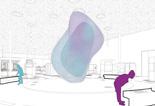




All the data is summarized, collected from time to time, and sent to screens located in three benches.
All the data is summarized, collected from time to time, and sent to screens located in three benches.
All the data is summarized, collected from time to time, and sent to screens located in three benches.
Making different decisions at the same time, using stands that affect the I-Center
All the data is summarized, collected from time to time, and sent to screens located in three benches. Making
All the data is summarized, collected from time to time, and sent to screens located in three benches.
I-Center is the main exhibit of Science Island. The sculpture is in an organic, irregular shape at the core of the Science Island, symbolizing a monument in the city center or a modern ‘living’ building. At the same time, the shape refers to the seed of a plant that we need to nurture.
All the data is summarized, collected from time to time, and sent to screens located in three benches. Making
Making different decisions at the same time, using stands that affect the I-Center
It integrates seven topics of the permanent exhibition, reflecting the idea, that all fields our activities influence the balance and wellbeing of our planet. The idea of the I-Center is to remind the visitors, that no matter what they are involved in at the moment (i.e. Transport, Communication or Energy) they need to consider the global perspective.
Trias 46 02 Kaunas | Lithuania
6
6 6
6
8 8
8
8
different decisions
stands that affect
at the same time, using
the I-Center
8
8
8
8
affect the I-Center
8 8
Additional scheme of the central exhibit (I-Center)
Making different decisions at the same time, using stands that affect the I-Center
8
8
and mix together, while pulsing at the same time. The opposing decisions are immediately transmitted via light paths to the lamps located above exhibits.
dots, appear
three large
hidden under a mirrored base. Than they
light
ceiling
reach
Then data and statistics, in form of floating
on
screens
use
paths on the
to
different decisions at the same time, using stands that affect the I-Center
Making decision, using stand that affect the I-Center 6 6 A positive decision is being made.
Additional scheme of the central exhibit (I-Center) Making decision, using stand that affect the I-Center 6 6 A positive
made.
decision is being
data is summarized, collected
sent
screens located in three benches.
from time to time, and
to
Additional scheme of the central exhibit (I-Center) Making decision, using stand that affect the I-Center 6 6 A positive
decision is being made.
Than
1.6.1.2.5.
1.6.1.2.5.
1.6.1.2.5. Additional scheme of the central exhibit (I-Center)
1.6.1.2.5.
1.6.1.2.5.






A negative decision is being made.
1.6.1.2.5.
1.6.1.2.5.
Additional scheme of the central exhibit (I-Center)
Additional scheme of the central exhibit (I-Center)
Additional scheme of the central exhibit (I-Center)
Additional scheme of the central exhibit (I-Center)
Additional scheme of the central exhibit (I-Center)


decision is being made.
A negative decision is being made.
A negative decision is being made.
A negative decision is being made.
A negative decision is being made.
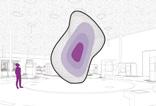



1.6.1.2.5.


1.6.1.2.5.
1.6.1.2.5.
After that the light falls directly into the middle of the sculture and creates a gentle, pulsing light effect.
After that the light falls directly into the middle of the sculture and creates a gentle, pulsing light effect.
After that the light falls directly into the middle of the sculture and creates a gentle, pulsing light effect.
After that the light falls directly into the middle of the sculture and creates a gentle, pulsing light effect.
After that the light falls directly into the middle of the sculture and creates a gentle, pulsing light effect.
After that the light falls directly into the middle of the sculture and creates a gentle, pulsing light effect.
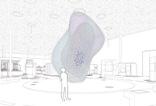






The negative decision is immediately transmitted via light path to the lamp located above an exhibit.
The negative decision is immediately transmitted via light path to the lamp located above an exhibit.
The negative decision is immediately transmitted via light path to the lamp located above an exhibit.
The negative decision is immediately transmitted via light path to the lamp located above an exhibit.
The negative decision is immediately transmitted via light path to the lamp located above an exhibit.
The negative decision is immediately transmitted via light path to the lamp located above an exhibit.






Then data and statistics, in form of floating dots, appear on three large hidden under a mirrored base.
Then data and statistics, in form of floating dots, appear on three large screens hidden under a mirrored base.
Additional scheme of the central exhibit (I-Center)
Then data and statistics, in form of floating dots, appear on three large screens hidden under a mirrored base.
Additional scheme of the central exhibit (I-Center)
Then data and statistics, in form of floating dots, appear on three large screens hidden under a mirrored base.






Than it uses the light path on the ceiling to reach the central exhibit.
Than it uses the light path on the ceiling to reach the central exhibit.
Than it uses the light path on the ceiling to reach the central exhibit.
Than it uses the light path on the ceiling to reach the central exhibit.
Then data and statistics, in form of floating dots, appear on three large screens hidden under a mirrored base. Than it uses the light path on the ceiling to reach the central exhibit.
Then data and statistics, in form of floating dots, appear on three large screens hidden under a mirrored base.






All the data is summarized, collected from time to time, and sent to screens located in three benches.
All the data is summarized, collected from time to time, and sent to screens located in three benches.
All the data is summarized, collected from time to time, and sent to screens located in three benches.
All the data is summarized, collected from time to time, and sent to screens located in three benches.
All the data is summarized, collected from time to time, and sent to screens located in three benches.
All the data is summarized, collected from time to time, and sent to screens located in three benches.
Making decision, using stand that affect the I-Center 1.6.1.2.5.

When visitor approaches, motion detector set the light being’s reaction - it is delicate and shy.

When visitor approaches, motion detector set the light being’s reaction - it is delicate and shy.

When visitor approaches, motion detector set the light being’s reaction - it is delicate and shy.
When visitor approaches, motion detector set the light being’s reaction - it is delicate and shy.
When visitor approaches, motion detector set the light being’s reaction - it is delicate and shy.
When visitor approaches, motion detector set the light being’s reaction - it is delicate and shy.
(Familiarisation)




Making decision, using stand that affect the I-Center
Making decision, using stand that affect the I-Center
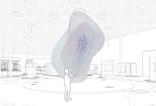

Making decision, using stand that affect the I-Center
The shape of the light continues to float, reacting to the movement of a person located at the motion sensor
The shape of the light continues to float, reacting to the movement of a person located at the motion sensor

The shape of the light continues to float, reacting to the movement of a person located at the motion sensor

The shape of the light continues to float, reacting to the movement of a person located at the motion sensor
The shape of the light continues to float, reacting to the movement of a person located at the motion sensor
The shape of the light continues to float, reacting to the movement of a person located at the motion sensor

Making decision, using stand that affect the I-Center
Making decision, using stand that affect the I-Center
When a person makes a slow movement, the light being in the I-Centre moves away, giving an expression of concern.

When a person makes a slow movement, the light being in the I-Centre moves away, giving an expression of concern.


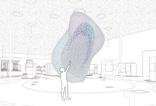


When a person makes a slow movement, the light being in the I-Centre moves away, giving an expression of concern.
When a person makes a slow movement, the light being in the I-Centre moves away, giving an expression of concern.
When a person makes a slow movement, the light being in the I-Centre moves away, giving an expression of concern.
When a person makes a slow movement, the light being in the I-Centre moves away, giving an expression of concern.
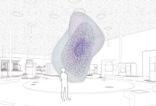



The light changes form when a new decision arrives or when it senses a chaotic movement.

When a person makes a sudden movement, light being in the I-Centre tries to hide, as if being afraid.
When a person makes a sudden movement, light being in the I-Centre tries to hide, as if being afraid.

The light changes form when a new decision arrives or when it senses a chaotic movement.

The light changes form when a new decision arrives or when it senses a chaotic movement.
The light changes form when a new decision arrives or when it senses a chaotic movement.
The light changes form when a new decision arrives or when it senses a chaotic movement.
The light changes form when a new decision arrives or when it senses a chaotic movement.
Visitors’ actions that effect the I-Center


When a person makes a sudden movement, light being in the I-Centre tries to hide, as if being afraid.
When a person makes a sudden movement, light being in the I-Centre tries to hide, as if being afraid.
When a person makes a sudden movement, light being in the I-Centre tries to hide, as if being afraid.
When a person makes a sudden movement, light being in the I-Centre tries to hide, as if being afraid.



The light takes on its full glowing form when it is calm.
The light takes on its full glowing form when it is calm.
The light takes on its full glowing form when it is calm.


The light takes on its full glowing form when it is calm.
The light takes on its full glowing form when it is calm.

The light takes on its full glowing form when it is calm.
9
Additional scheme of the central exhibit (I-Center) 9 9
Visitors’ actions that effect the I-Center
Visitors’ actions that effect the I-Center
Visitors’ actions that effect the I-Center
The ‘behavior’ of the exhibit is strongly reminiscent of emotional living being. Change in intensity of lights inside the I-Center reflects its ‘emotional’ state. When visitor’s decisions at the exhibition lead to increased pollution, the lights of the I-Center change dramatically, creating an impression of the rapid heart pulse or quick breathing. On the other hand, when the visitors make sustainable choices, the central exhibits reacts with warm, relaxed, pulsating lights, and even funny glitters and light shows. The impression that the sculpture is alive is enhanced by its reaction to the visitors.
9
Visitors’ actions that effect the I-Center 9 9
9
9
47 Science Island in Kaunas
9
9
9
First
Uncertainty Agitated Fear Calm
contact Hello (Familiarisation)
that effect the
Visitors’ actions
I-Center
9
First contact Hello
Uncertainty Agitated Fear Calm
First contact Hello
Uncertainty Agitated Fear Calm
(Familiarisation)
7 7
7 7
A negative
7 7
7
7
7
7
7
7
Than it uses the light path on the ceiling to reach the central exhibit.
03 | COMPLETED PROJECTS
MARITIME SCIENCE CENTER IN SZCZECIN
PROJECT
IN FIGURES: of floor space thematic zones permanentexhibits floors
3100 m 2 3 5 213
The Prof. Jerzy Stelmach Marine Science Centre (MCN) is Poland’s largest science center dedicated to water and shipping.
The MCN’s leitmotif is the sea - a subject that allows for an attractive presentation of issues in the fields of physics, mathematics, astronomy, geography, medicine, technology, ecology, sociology, history or culture, among others.
Showing a variety of phenomena by means of examples related to sailing, waves, wind, fishing or harbor life
will makes it a unique facility not only in Europe, but also worldwide.
The permanent exhibition is located on three floors of the center’s building, totaling some 3100 m2
TRIAS is responsible for the full realization of the exhibition - from the concept, architectural design and design of the multimedia systems, through set design and preparation of applications for multimedia devices, to the construction and installation of the exhibits.
50 Trias Szczecin | Poland 02
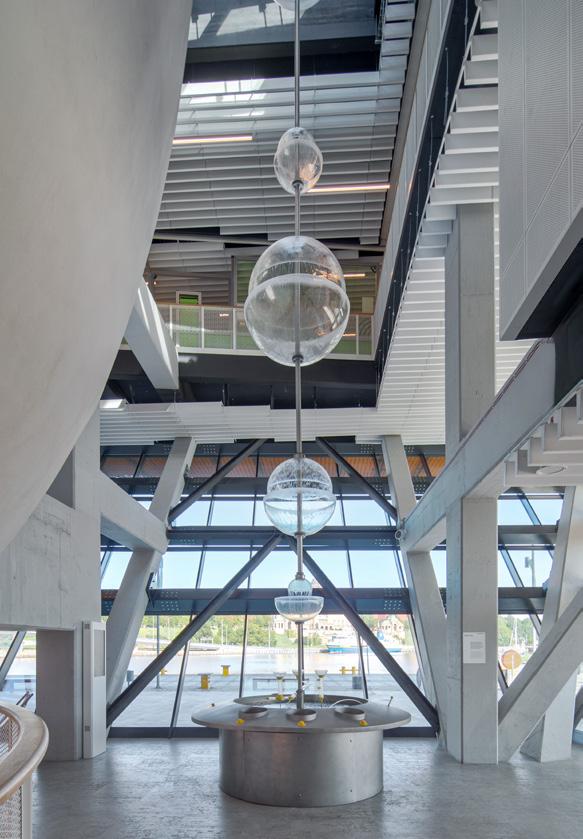
Maritime Science Center in Szczecin


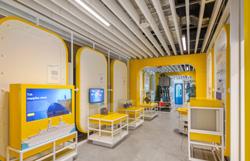
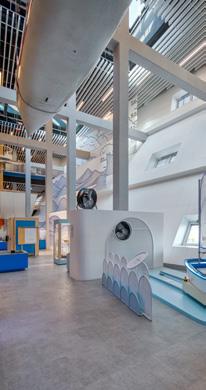
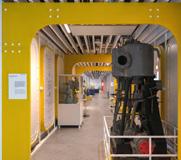
Trias 52 02 Szczecin | Poland 03 04 02 01 01 | 02 | 03 | 04 | 05 | 06 | 07 | Full steam ahead thematic zone




53 Maritime Science Center in Szczecin 07 06 05


Trias 54 02 Szczecin | Poland 08 | 09 | Splash! thematic zone 08

55 Maritime Science Center in Szczecin 09
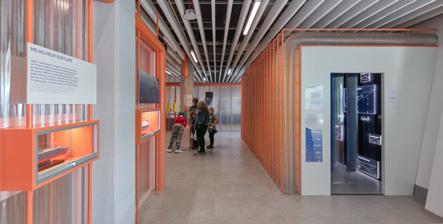

Trias 56 02 Szczecin | Poland 10 | Sea element thematic zone 10
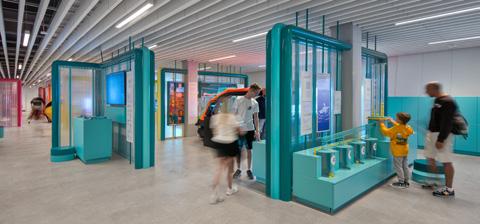


57 Maritime Science Center in Szczecin 11 | 13 | Sea element thematic zone 12 | Which way to Africa? thematic zone 11 12 13



Trias 58 02 Szczecin | Poland 14| 15 | Sea element thematic zone 14 15
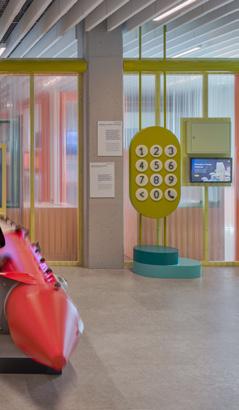
The MCN is the largest science center in Poland dedicated to water and shipping in its broadest sense. A broad range of diverse exhibits is available to visitors. There are fully interactive devices, some operate on water and others use advanced AV solutions and dedicated applications. There are also some exhibits that use motion detection technology. The whole exhibition has been wrapped in a coherent scenographic design.
-
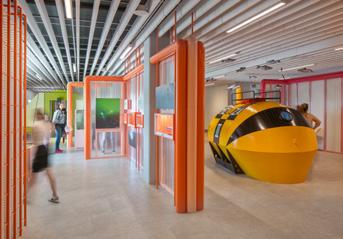
59 Maritime Science Center in Szczecin 16 | 17 | Which way to Africa? thematic zone
16 17
Jacek Augustyn, Project Manager at TRIAS
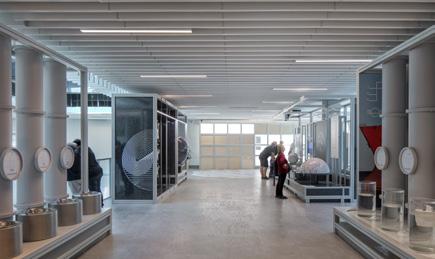

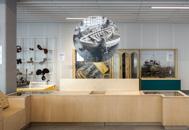
Trias 60 02 Szczecin | Poland 20 | Full steam ahead thematic zone 18 | 19 | 21 | Which way to Africa? thematic zone 18 19 20 21
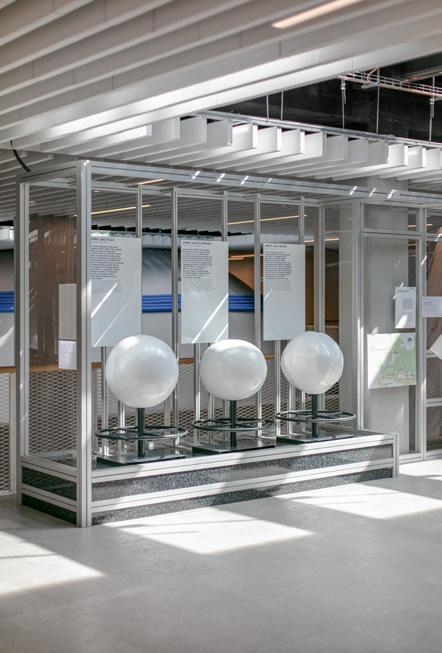
61 Maritime Science Center in Szczecin

Trias 62 03 Szczecin | Poland

63 22 22 | Full steam ahead thematic zone Maritime Science Center in Szczecin
EPI-CENTRE OF SCIENCE IN BIALYSTOK
PROJECT IN FIGURES:
3200 m2 of floor space
16
140
permanent exhibits thematic zones
Epi-Centre of Science is the largest science centre in Poland east of Vistula river. Established to promote science, research and innovation, the institution is a creative space to explore inventions, technologies and laws of
nature. You will find exhibits covering topics from the following fields: optics, transport, telecommunications, medicine, automation, robotics, mechanics and many more. Each thematic zone is distinguished by a sceno-
graphy that relates to specific subject. The exhibition offers a immersive journey for everyone, regardless of age: young and old, children and adults, students and teachers.
Trias 64 Bialytstok | Poland 03
01 01 | The Power of Water thematic zone

65



Trias 66 03 Bialytstok | Poland 04 02 03 02 | 03 | Telecomunication thematic zone 04 | Material Properties thematic zone


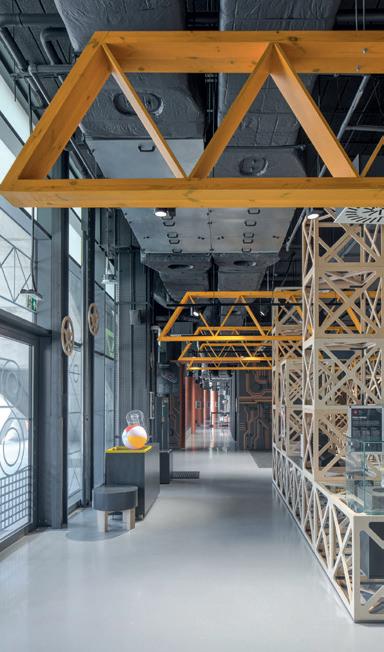
67 Epi-Centre of Science in Bialystok 05 06 05 | Automation and Robotics thematic zone 06 | Mechanics thematic zone




Trias 68 03 Bialytstok | Poland 07 08 07 | 08 | 09 | 10 | Go with the Current thematic zone
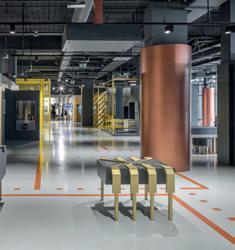

69 Epi-Centre of Science in Bialystok 09 10
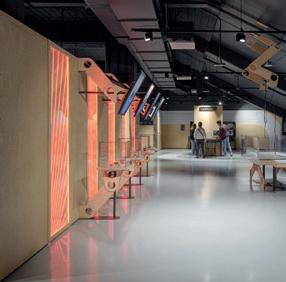
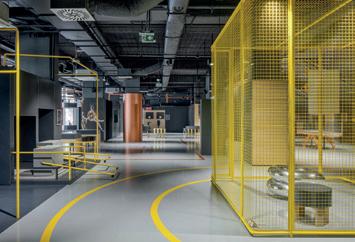

Trias 70 03 Bialytstok | Poland 12 13 11 11 | Automation and Robotics thematic zone 12 | Transport thematic zone 13 | Exciting Technologies thematic zone


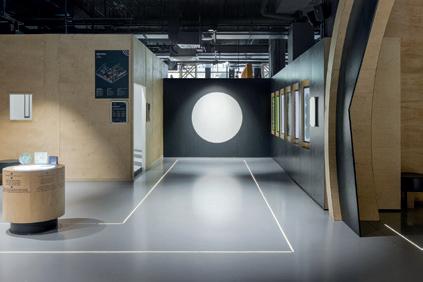
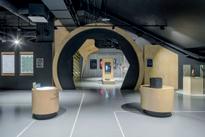

71 Epi-Centre of Science in Bialystok 14 15 16 14 | 15 | 16 | Optics thematic zone
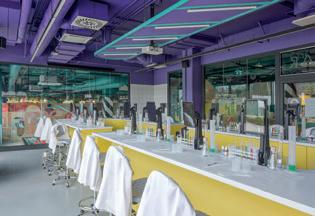
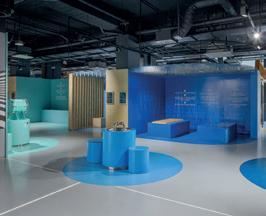
Designing Epi-Centre of Science was a real treat for creative architects, because aside from being a fascinating science center with fantastic exhibits, it also required a coherent architectural concept with plenty of scenography. Each of eleven thematic zones of the main exhibition has a unique design motif - colors, shapes, materials and patterns, that originates from the addressed subject matter.
- Mateusz Morski, Creative Director at TRIAS
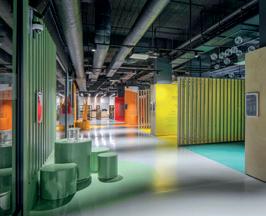
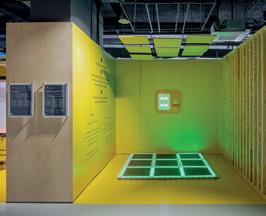
Trias 72 03 Bialytstok | Poland
17 18 | 19 | 20 | View on The Power of water thematic zone 17 | Lab




73 Epi-Centre of Science in Bialystok 18 19 20 21 21 | Exhibits in the Play with science thematic zone

Trias 74 03 Bialytstok | Poland
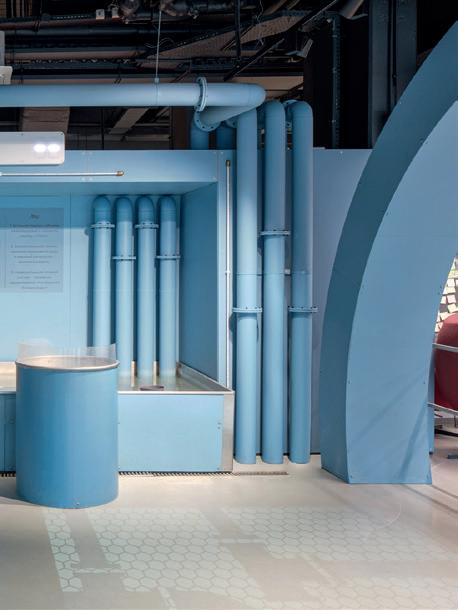
75 Epi-Centre of Science in Bialystok 22 22 | The Power of Water thematic zone
EXPOSITION AT NATIONAL BANK OF POLAND
2 000 m2 of floor space
250 PROJECT IN FIGURES:
the history of money. One can witness the birth of the coin and banknote, the first banks, economic theories, see how money is created, how an ATM and credit card work. In addition to over permanent exhibits
Occupying over 2000 sq. m museum focuses on direct contact with the history of money, the economy and its mechanisms. It is a kind of time machine that takes visitors to the key places in
10000 traditional exhibits, numismatic items and information texts, it offers over 250 interactive multimedia stands.
Trias 76 Warsaw | Poland
03
01 01 | Cenral bank room

77
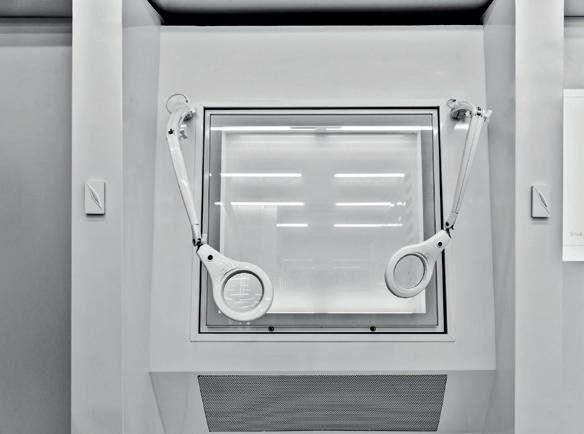
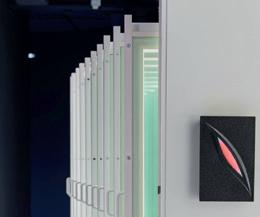
Trias 78 Warsaw | Poland 03 03 02 02 | Banknote production station 03 | Display cabinets





79 Exposition at National Bank of Poland 06 05 04 04 | Vault, safe deposit boxes 05 | Money quiz - interactive app 06 | History of money
This was a very prestigious project in the center of Polish capital city. Because of that we were able to use the best materials and technology available at that moment. To this day it is one of the most interesting tourist attraction in Warsaw.
- Jakub Szymus, Technical Director at TRIAS


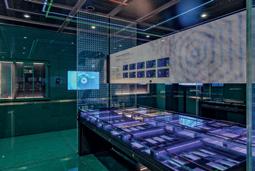
Trias 80 Warsaw | Poland 03
07 07 | Stock market simulation
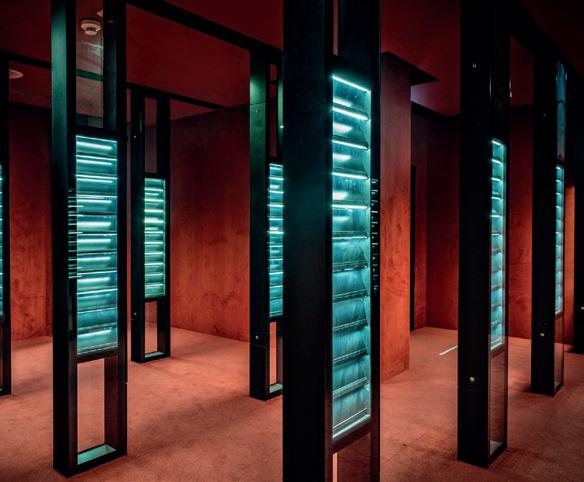

81 Exposition at National Bank of Poland 10 09 08 | 09 | 10 | Numismatic collection 08

Trias 82 03 Warsaw | Poland
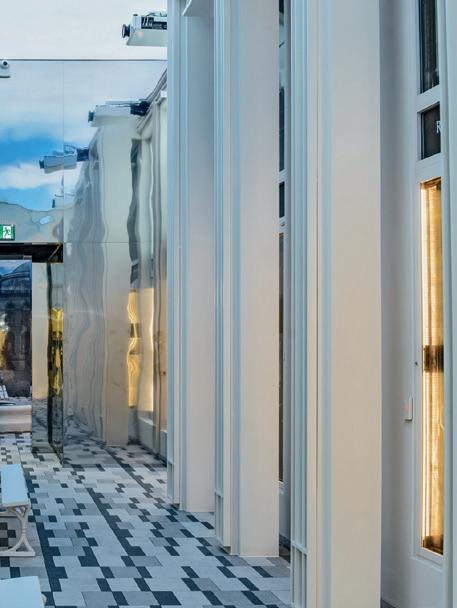
83 Exposition at National Bank of Poland 11 11 |Main Bank Street; projected scenography in the background
MUFO MUSEUM OF PHOTOGRAPHY IN CRACOW
PROJECT IN FIGURES:
700 m2
2
5 55
of floor space thematic zones permanent exhibits floors
The new multimedia-rich exhibition ‘What Makes Photo?’ at the Museum of Photography in Cracow (MuFo) is the first exhibition in Poland to present a cross-sectional view of the history of photography, its present and it’s future. Visitors have the opportunity to learn about different photographic techniques, to understand how modern prints are made, but also to find out what methods were previo-
usly used to record images on paper. The new exhibition also features an extensive collection of works by Polish photographers. Another important aspect of the exhibition is the presentation of the cultural significance of photography - how it was used to convey information, but also to influence public opinion. The arrangement of the exhibition gives visitors the opportunity to explore,
experience and freely contemplate the main themes of the exhibition. Original exhibits, reproductions and factual content are presented in the exhibition using alternating forms - hands-on interactive elements, texts and infographics, allowing visitors to experiment and discover on their own. TRIAS was responsible for the creation of the exhibition.
Trias 84 03 Cracow | Poland
01 01 |‘What makes photos?’ Exhibition

85
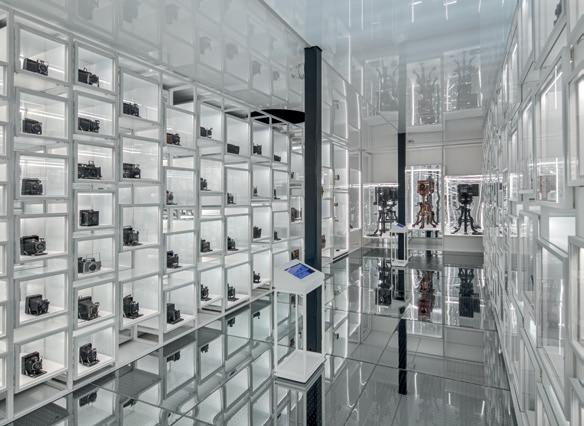
Trias 86 03 Cracow | Poland 02 02 | 03 | 04 | 05 | Future thematic zone
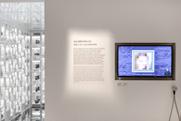

When we embarked on the realization of the MuFo in Cracow, we were given a very interesting architectural space, which we successfully managed to transform into the unique exhibition regarding the history and future of the art of photography. One of the most interesting challenges during this accomplishment was a close cooperation with the local conservator of monuments, whose role was to assure that the effects of our work were consistent with the rules of proper display of historic photographs.
- Filip Prasal, Sales Manager at TRIAS
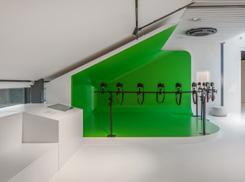
87 MUFO Museum of Photography in Carcow
03 05 04 05 | Bullet time exhibit; Future thematic zone


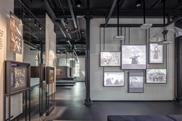
Trias 88 03 Cracow | Poland 07 06 06 | Photographer thematic zone 07 | Contemporary Reportage, Information thematic zone


89 MUFO Museum of Photography in Carcow 08 09 09 | Technology thematic zone 08 | Application to control the illumination of display cases; Future thematic zone

Trias 90 03 Cracow | Poland 10 10 | Crowd art installation; Photographer thematic zone


91 MUFO Museum of Photography in Carcow 11 11 | Crowd art installation; Photographer thematic zone
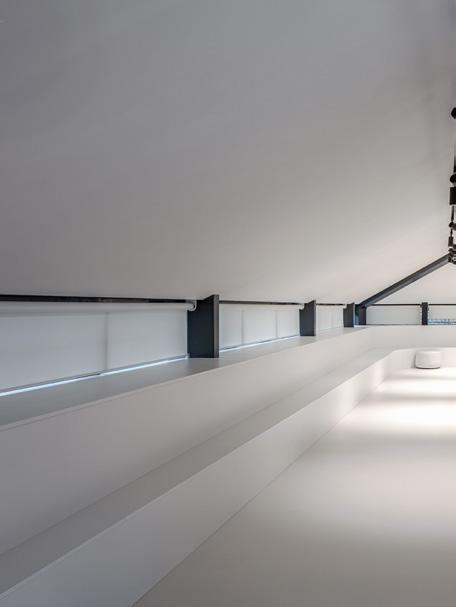
Trias 92 03 Cracow | Poland

93 MUFO Museum of Photography in Carcow 12 12 | Future thematic zone
GEN SCIENCE GENERATOR IN JASLO
PROJECT
IN FIGURES:
7
62
interactive exhibits
24
700 m2 over of floor space thematic zones multimedia exhibits
GEN Science Generator in Jaslo is an ambitious science centre with an immersive and well-thought narration and a lot of interactive exhibits. Seven thematic zones refer to the local, industrial
cultural heritage, present how science influences people’s everyday life in these areas and show what may await us in the future. The concept of the exhibition identifies popular science
thematic zones linked to the local and regional industrial cultural heritage, drawing on the potential of the city of Jaslo and the region but also reaching far into the future.
Trias 94 03 Jaslo | Poland
01 01 | Energy of Flows and Waves exhibit; What Energy...? thematic zone
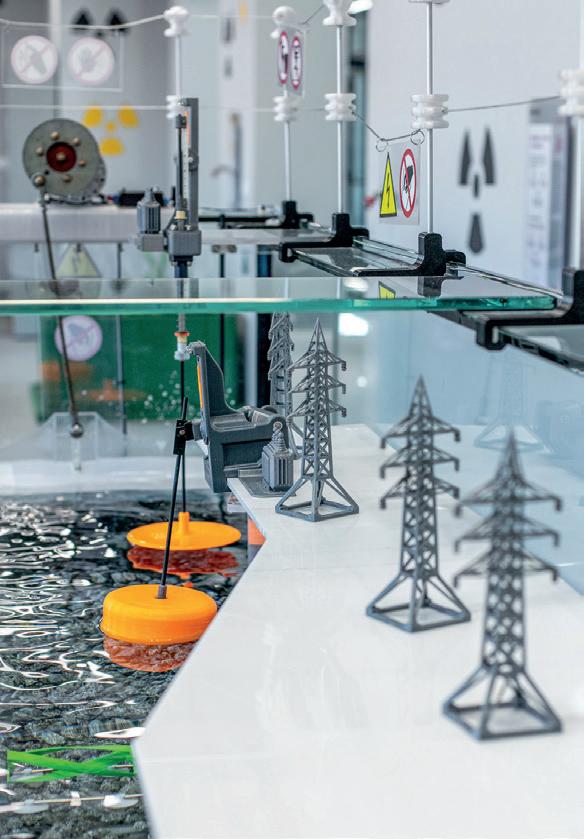
95
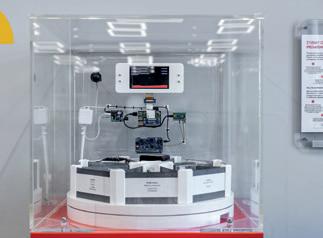
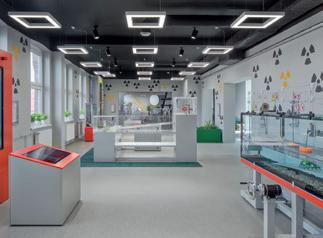
GEN Science Generator was a bold project that resulted in the rich in content science center. Covering multiple STEM topics, it is first and foremost a great way to interest younger generation in science and technology. Thanks to that, the GEN became one of major tourist attraction in town of Jaslo.
- Radoslaw Cetner, Project Manager at TRIAS
Trias 96 03 Jaslo | Poland
03 02 02 | We Live With Radiation exhibit; What Energy...? thematic zone 03 | 05 | View on ‚What energy...?’ thematic zone
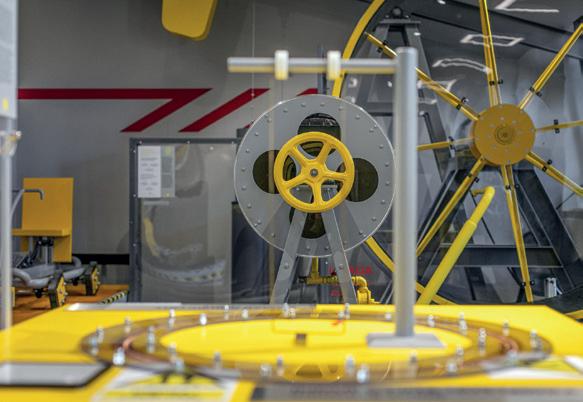

97 GEN Science Generator in Jaslo 05 04 04 | World in Motion thematic zone

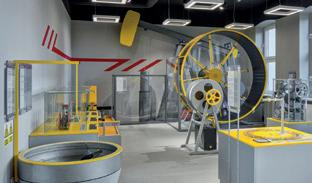
Trias 98 03 Jaslo | Poland 06 07 06 |
|
Kinetic Friction in Liquids exhibit; World in Motion thematic zone 07
Planets exhibit; Voyage to Mars thematic zone



99 GEN Science Generator in Jaslo 09 08 08 |
thematic zone 09 | World in
thematic zone
Goldberg Machine exhibit; World in Motion
Motion
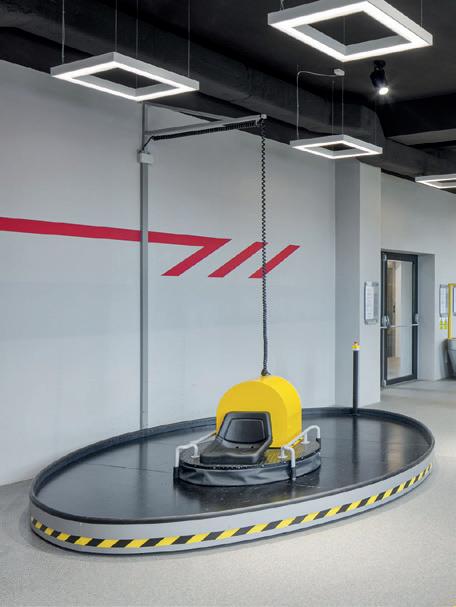
Trias 100 03 Jaslo | Poland

101 GEN Science Generator in Jaslo 11 11 | World in Motion thematic zone
EDUCATION CENTER OF THE WARTA MOUTH NATIONAL PARK IN SLONSK
PROJECT
IN FIGURES:
900 m2 of floor space
100
12
permanent exhibits high-end multimedia projectors creating 3D mapping Balloon Flight
The main goal of the Education Center of the Warta Mouth National Park is to present the natural values of the Warta Mouth - both fauna, flora and geography of
the area. Numerous and interesting multimedia, interactions, graphics, models (e.g. of an airplane fuselage, a river bank or a beaver lodge), exhibits and models
create a very interesting and varied exhibition, which will be of interest not only to younger viewers, but also to adults.
Trias 102 Slonsk | Poland 03
01 01 | A projection mapping imitating baloon flight over the Park, Balloon Flight thematic zone

103



Trias 104 03 Slonsk | Poland 05 03 02 04 02 | Similar to Birds thematic zone 03 | Similar to Birds thematic zone 04 | Four Seasons of the Year thematic zone
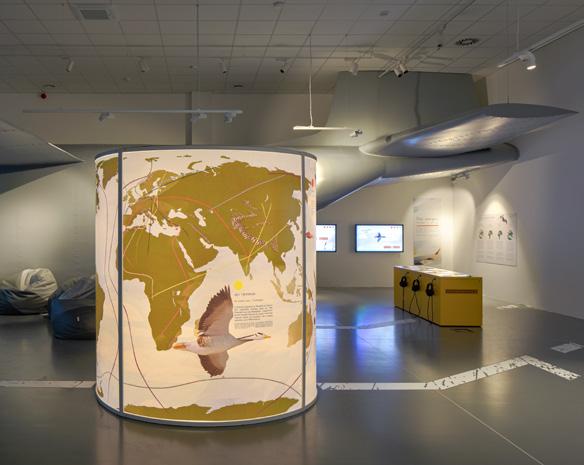


105
06 06 |
05 | Four Seasons of the Year thematic zone
Education Center of the Warta Mouth National Park in Slonsk
Mock-up of a riverbank and a large-scale aquarium; River thematic zone

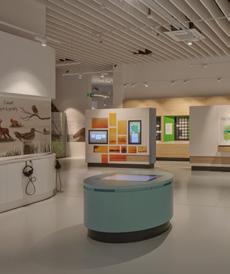
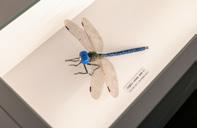
Trias 106 03 Slonsk | Poland 07 08 07 | Laboratory thematic zone 08 | Model of a dragonfly; Laboratory thematic zone


The use of modern technology for educational purposes has a very positive effect on reception of the content. Cooperation with the Warta Mouth National Park has resulted in an exhibition space unique in Poland, combining traditional exhibits and models with innovative multimedia solutions. The exhibition project was created in agreement with the construction project. As a result, there was space for such unique exhibits like the Baloon Flight or aquarium.
- Marcin Wojczynski, Vice-president at TRIAS
107 Education Center of the Warta Mouth National Park in Slonsk
09 10 09 | Laboratorium thematic zone 10 | Laboratory and Tourist Attractions thematic zones

Trias 108 03 Slonsk | Poland
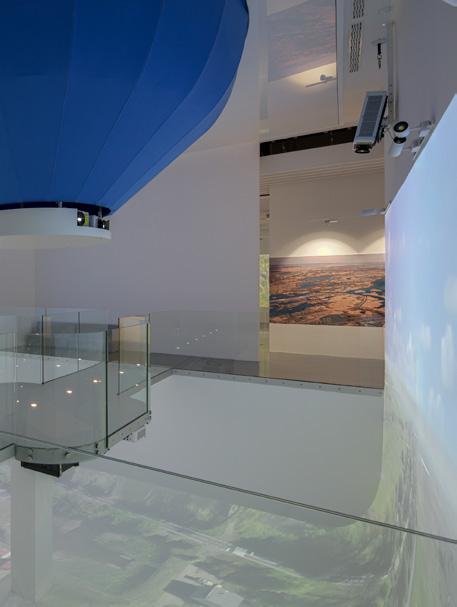
109 Education Center of the Warta Mouth National Park in Slonsk 11 11 | A projection mapping imitating baloon flight over the Park, Balloon Flight thematic zone
MOTOEXPERYMENTARIUM - ART DEPOT IN SZCZECIN
PROJECT IN FIGURES:
200 m2 of exhibition space
15
interactive exhibits
The new space at Museum Of Technology And Transport - Art Depot is a permanent interactive exhibition, arranged as a modern vehicle inspection station. The
theme of the new exhibition is automotive industry, one of the fastest growing and changing areas of life. It is also a story about the history of technology in Pome-
rania. In keeping with the idea of the exhibition, it designed as a workshop of an enthusiast who appreciates both the past and innovations of technology.
Trias 110 Szczecin | Poland 03
01 01 | Vehicle Inspection Station exhibit

111



Trias 112 Szczecin | Poland 03 03 02 02 | Traffic Regulations - thematic zone 03 | Let’s Meet exhibit

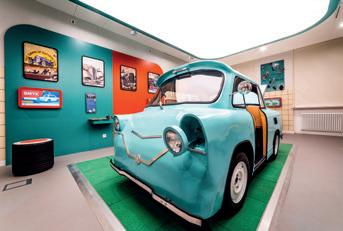
This exhibition is mainly based on mechanical and mechatronic solutions. Multimedia devices, on the other hand, are only a supplement, helping to convey substantive issues.

113 Motoexperymentarium - Art Depot in Szczecin
04 05 03 | Vehicle Inspection Station exhibit 04 | Good System exhibit
- Aleksandra Litwora, Architect at TRIAS
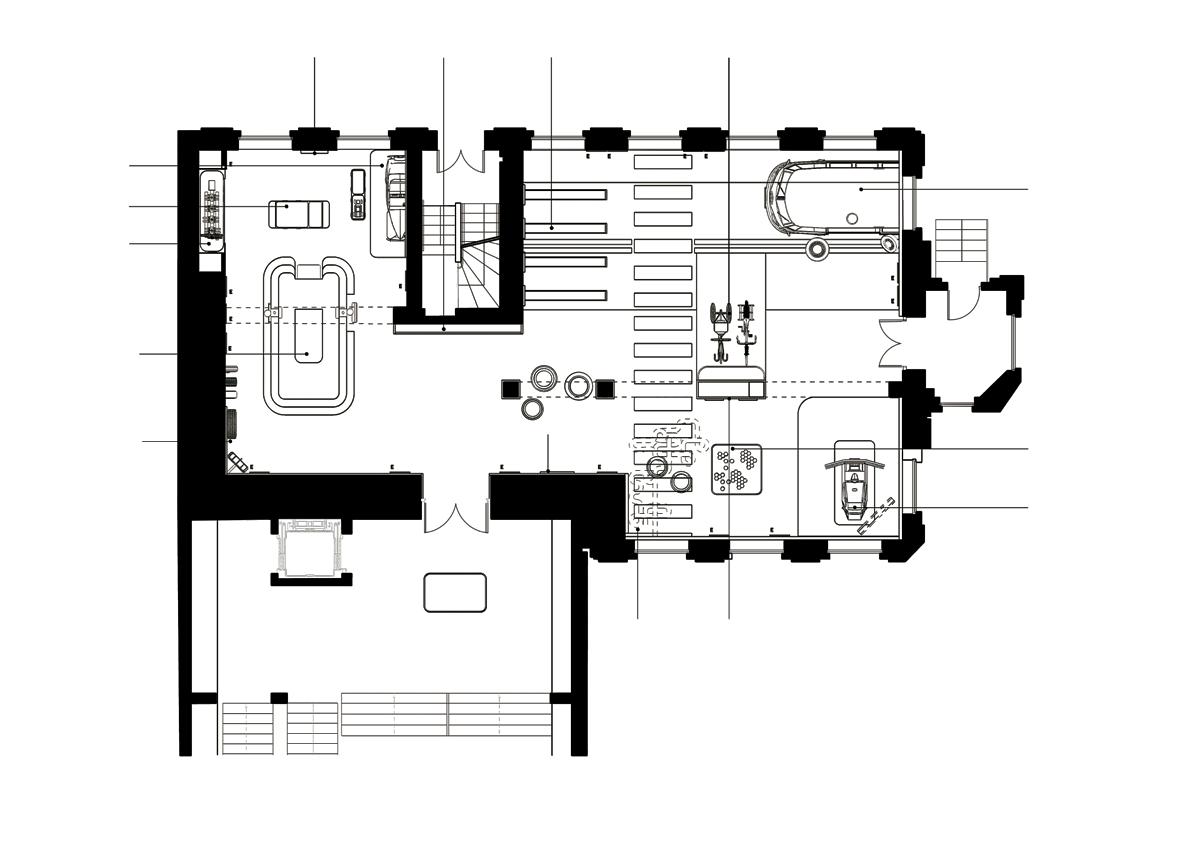
Trias Szczecin | Poland 03

Motoexperymentarium - Art Depot in Szczecin
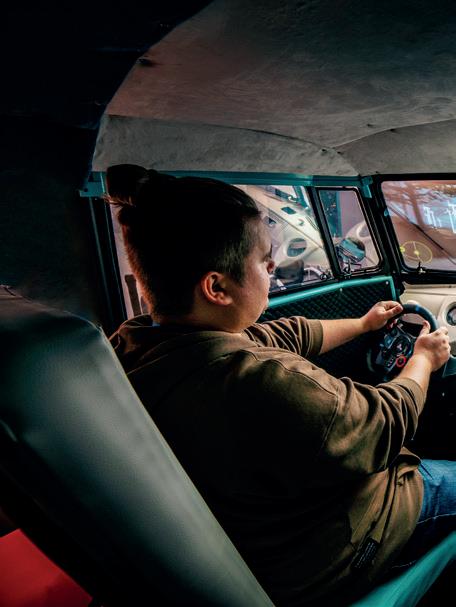
Trias 116 Szczecin | Poland 03

117 Motoexperymentarium - Art Depot in Szczecin 05 05 | Cockpit exhibit
ART DÉCO EXHIBITION IN PLOCK
PROJECT IN FIGURES:
700 m2
2
1800
of exhibition space floors antique pieces
Art Déco exhibition, a part of Mazovian Museum in Plock is the largest presentation of the art collection of the 1920s and 1930s in Poland.
The tour begins with an interactive calendar introducing the exhibition. The ground floor exhibition is an urban imitation of the city at night, which perfectly creates the atmosphere of the inter-war period and the art déco style. Here you can see the interiors of townhouses, the Fashion House with its extensive collection of costumes and accessories, a jeweller’s
shop, a bank and a mini-cinema. These spaces display the historic collections and faithfully reflect the atmosphere of the era. The dominant feature of the urban development is a vintage 1926 JOWETT Special Roadster car. The exhibition is complemented by a number of interactive stations, operated via touchscreen monitors. Also noteworthy is the 3D mapping, created using high-end projectors, which complements the architecture and brings the space to life.
On the first floor, visitors can see an arranged inter-war flat with interiors - living room, dining room, bedroom and kitchen. In addition, the exhibition area includes an arts and crafts gallery, comprising utilitarian and decorative wares in glass, ceramics and metal, as well as sculptures and paintings - including Tamara Lempicka’s ‚Still Life’. In the central section is the Hall of Identity, thematically referring to the Polish pavilion created for the 1925 International Exhibition of Decorative Arts and Design in Paris. 01
Trias 118 03 Plock | Poland
01 | Showcase of a boutique
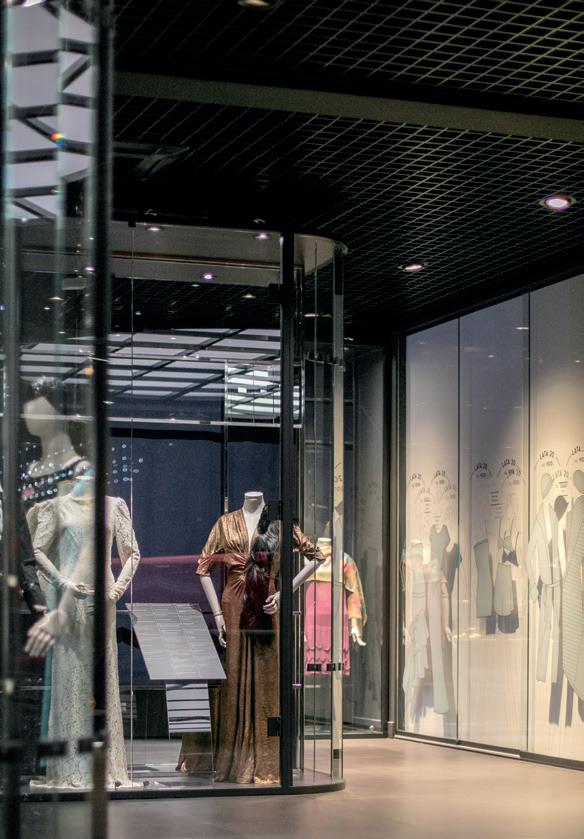
119
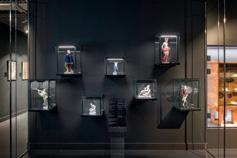
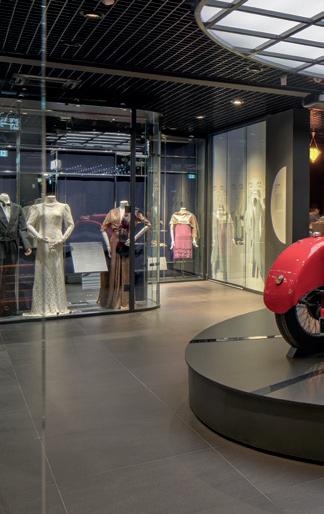
Trias 120 03 Plock | Poland 02 04 03 02 | Jowett car from 1926 03 | Ceramics design gallery
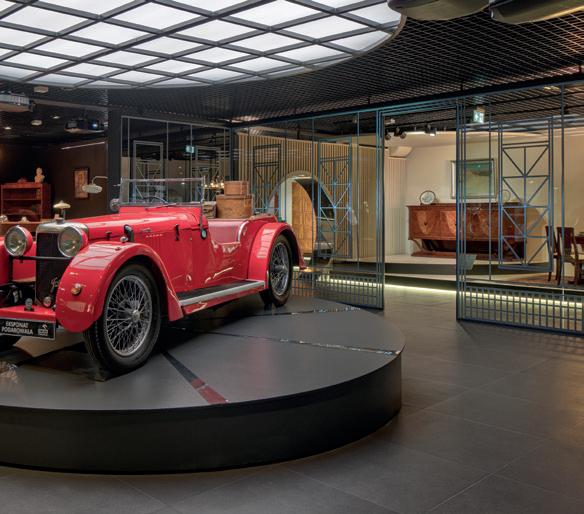
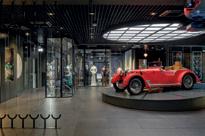
121 Art Déco exhibition in Plock 04 | Design dallery of glass products




Trias 122 03 Plock | Poland 07 06 05 05 | Odeon cinema neon 06 | 07 | Identity hall
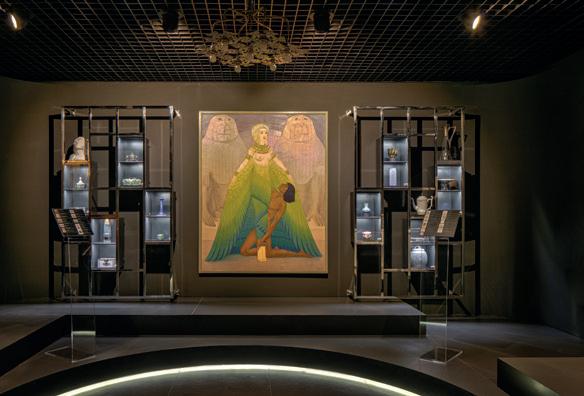
The new permanent Art Déco exhibition in Plock is a unique combination of historical exhibits, perfectly designed and arranged space and modern audio-video technology. By combining all the elements, we have managed to tell the story of this unique period in Polish art in a credible and interesting way.
- Maciej Beres, Architect at TRIAS AVI
123
Déco exhibition in Plock 09 08 | Tenement from 1910
Art

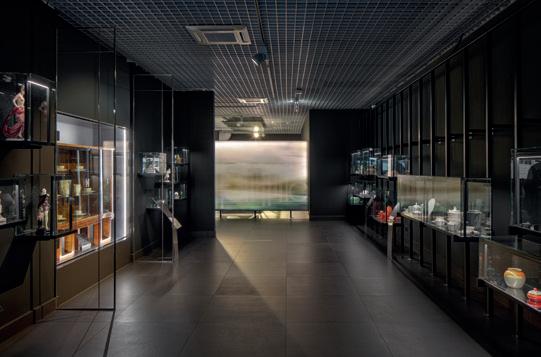
Trias 124 03 Plock | Poland 10 09 | 10 | Design dallery of glass products 09

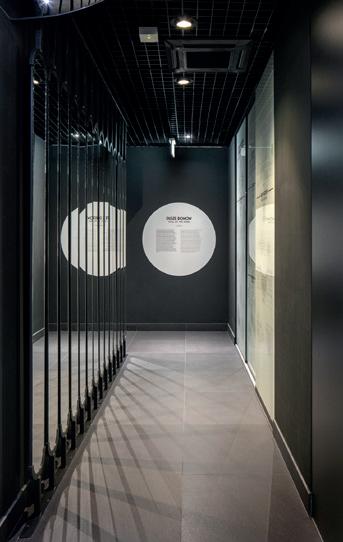
125 Art Déco exhibition in Plock 11 11 | Identity hall

Trias 126 03 Plock | Poland
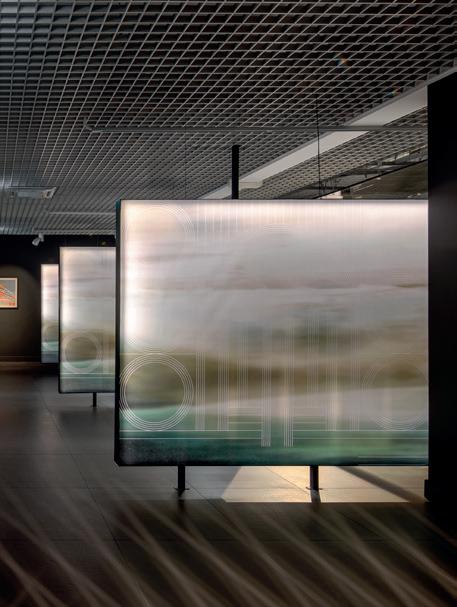
127 Art Déco exhibition in Plock 12 12 | Design dallery of glass products
NATIONAL TECHNOLOGY MUSEUM IN WARSAW
PROJECT IN FIGURES:
1100 m2
50 300 25
of floor space exhibits multimedia applications showcases and displays
Almost 1100 m2 of re-arranged space, new exhibition elements and invariably fascinating, also previously unpresented historic technological achievements – this is the new National Museum of Technology in Warsaw. The new exhibition entitled: ‘Poles’ contribution
to the world’s technical and scientific heritage’ tells the long story of the development of Polish technical thought, focusing in particular on the most significant engineering and scientific achievements of the period between the 17th and 20th centuries. Visitors will also be
able to learn about mathematics, see the development of tools and technical drawing - in a word, everything that builds the language of technology, without which the technological progress that has been going on for years, would not have been possible. 01
Trias 128 Warsaw | Poland 03
01 | Central interactive exhibit with touchscreen monitors and Demoiselle aircraft replica



Trias 130 Warsaw | Poland 03 03 02 02 | 03 | 04 | 05 | Socket: Universal History; Auxiliary Exhibition Room



131 National Museum of Technology in Warsaw 05 04
The National Museum of Technology has a lot of a great exhibits of vintage technology. For example, we have installed a Demoiselle aircraft replica five meters above the rotunda floor and an original Fort T on the special tilted platform. Because the Museum is under conservation protection, we could not interfere with the building structure and had to build a specially designed steel constructions. This was both demanding and complicated but finally we have managed to create an entire installation capable to hold the heavy exhibits and other scenography inside the building.
- Tomasz Skrzypczak, Project Manager at TRIAS

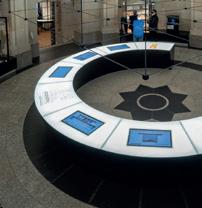
Trias 132 Warsaw | Poland 03 06 | 07 | Demoiselle aircraft replica


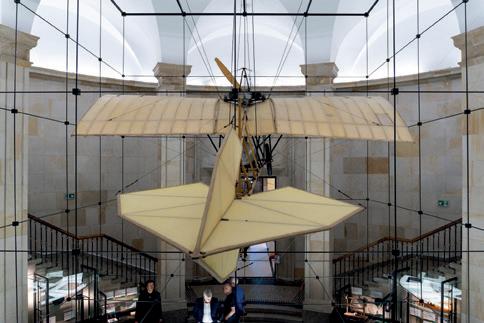
133 National Museum of Technology in Warsaw 08 06 07 08 | Central interactive exhibit with touchscreen monitors

Trias 134 Warsaw | Poland 03 09 09 | Ingenious Visionaries thematic zone



135 National Museum of Technology in Warsaw 12 11 10 10 | TV set from circa 1948 12 | Main exhibition with a LED curtain in the background 11 | Central interactive exhibit with touchscreen monitors

Trias 136 Warsaw | Poland 03
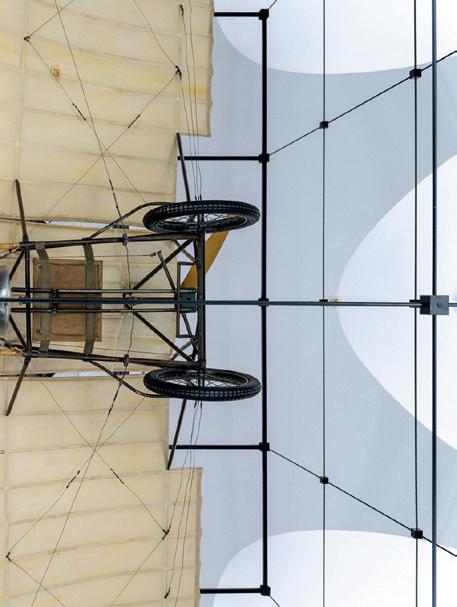
137 National Museum of Technology in Warsaw 13 13 | Demoiselle aircraft replica
COPERNICUS SCIENCE CENTER IN WARSAW
Copernicus Science Center in Warsaw is one of largest and renowned educational institution in Europe. In 2022 TRIAS has created a part of new ‘Future is Now’ exhibition. The exhibits re-
fer to problems of pollution, deforestation of urban areas, energy production and consumption. There is also an exhibit explaining 5G signal coverage and one describing the importance of
so-called seed banks, which are meant to help biodiversity conservation. All elements of exposition are interactive with both multimedia and hands-on solutions.
Trias 138 03 Warsaw | Poland
01
01 | Stable Power exhibit
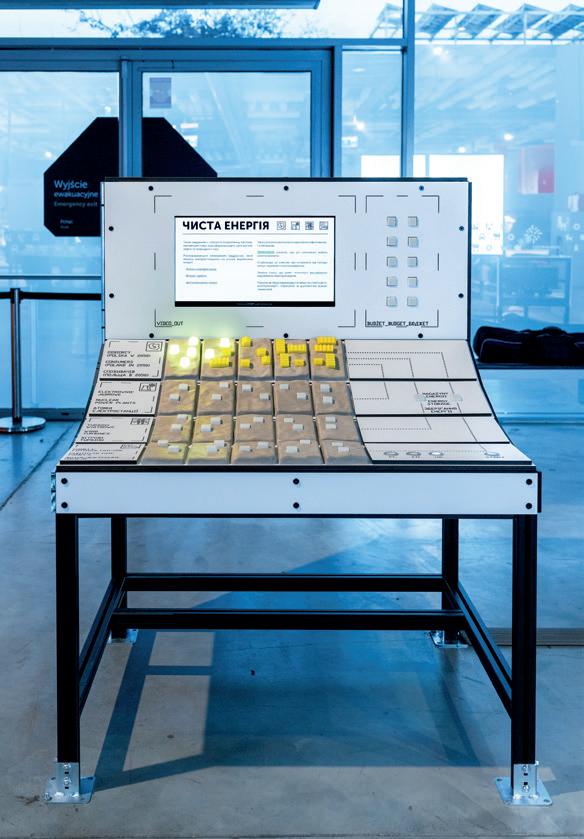
139


Trias 140 03 Warsaw | Poland 03 02 02 | 03 | Road to Global Warming exhibit
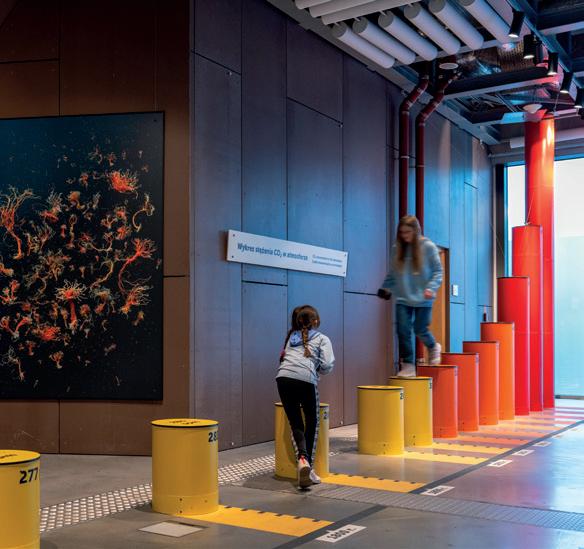
141 Copernicus Science Center in Warsaw


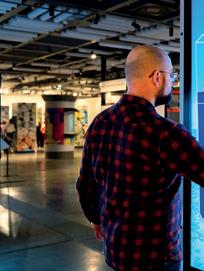
Trias 142 03 Warsaw | Poland 05 06 04 04 | Vault exhibit 05 | 06 | 08 | Your Carbon Footprint exhibit
It is very rewarding when our software is being used by roughly a million of visitors each year. Because the apps in Copernicus Science Center are being used by people in different age groups, accessibility and UX were crucial for us. The openness and competence of the Copernicus team, together with a shared awareness of purpose, made it possible to create best solutions in terms of the usefulness and value of the experience for visitors.
- Jakub Ostrowski, Software Development Manager at TRIAS
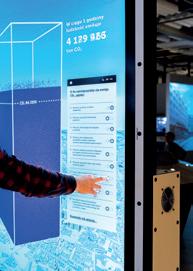
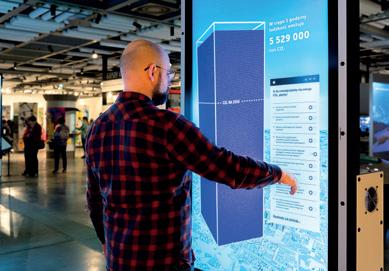
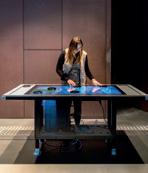
143 Copernicus Science Center in Warsaw
07 08 07 | 5G Table exhibit
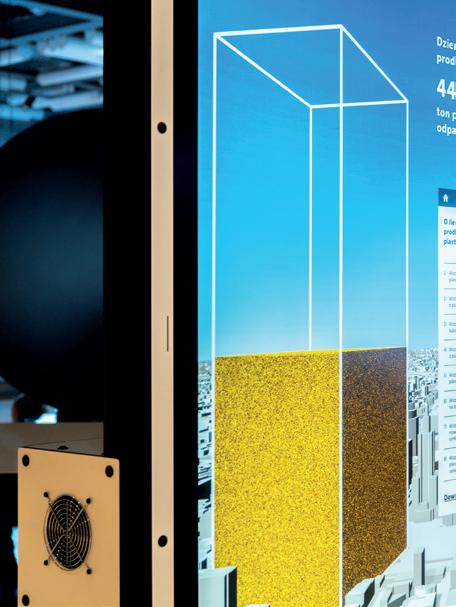
Trias 144 03 Warsaw | Poland
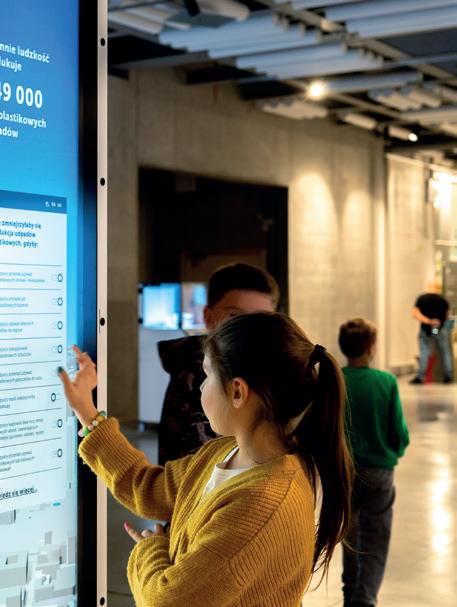
145 Copernicus Science Center in Warsaw 09 09 | Your Plastic Footprint exhibit
146
21 Kabaretowa Street Warsaw
sekretariat@trias.pl
T: + 48 22 839 49 35
M: + 48 509 920 767
147
concept and graphic design
Ewelina Jalocha
Mateusz Morski
photos
Piotr Krajewski
Maciej Bultowicz
Mateusz Morski
Marcin Giers
special thanks to
Marcin Wojczynski
Dawid Polasik
Jakub Szymus
Michal Kowalczyk
Maciej Beres
Aleksandra Adamczyk
Aleksandra Litwora
Klaudia Walaszek-Wieczorek
Radoslaw Cetner
Jacek Augustyn
Tomasz Skrzypczak
Jakub Ostrowski
Roman Zwiejski
copywriting
Maciej Bultowicz
148
Centrum Popularyzacji Nauki i Innowacji
Uniwersytetu
”Kortosfera” 149
Warmińsko-Mazurskiego























































































































































































































































































